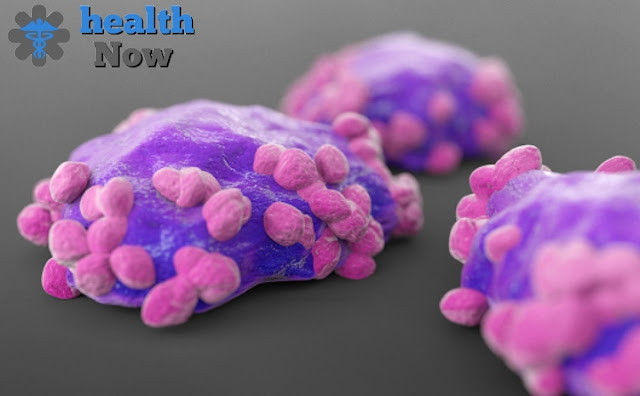Blood Cancer - Leukemia.
 |
| Leukemia-symptoms and traitement. |
Leukemia or blood cancer is a sort of disease of the platelets and tissues that produce platelets like the bone marrow. In a typical well-being circumstance.
platelets emerge in the bone marrow as immature microorganisms, and later mature to shape various sorts of platelets (red platelets, white platelets, or platelets), and move into the circulatory system.
Concerning somebody who experiences leukemia, his bone marrow starts to create unusual white platelets that enter the circulatory system and start to rival sound typical platelets, keeping them from carrying out their roles appropriately.
Types of blood cancer (leukemia).
Intense leukemia: It develops and deteriorates rapidly, and can life-compromise. In this kind, the bone marrow starts creating enormous quantities of juvenile white platelets called impacts, which enter the circulation system.
These juvenile cells rapidly rival the typical cells in the circulatory system and don't go about their business of battling contamination, halting draining, or causing pallor, making the body extremely feeble.
- Acute lymphoblastic leukemia (ALL).
- Acute myeloid leukemia (AML).
Chronic leukemia: It develops slowly and gets progressively worse, and symptoms may take a long time before they appear.
Sometimes chronic leukemia is diagnosed (through routine screening) before any symptoms appear because the cancer cells are mature enough to function like normal white blood cells before they start to progress.
Types of chronic leukemia:
- Chronic lymphocytic leukemia (CLL).
- Chronic myelogenous leukemia (CML).
There is another sort called bushy cell leukemia, which is an uncommon kind named by its appearance under the magnifying lens.
This kind of leukemia for the most part influences the old, and men more than ladies, and its most normal side effects incorporate shortcoming and exhaustion because of paleness.
Risk factors that increment the possibilities of creating leukemia.
- Exposure to high levels of radiation.
- smoking.
- Openness to benzene (utilized in the substance businesses, and tobacco smoke).
- Specific sorts of chemotherapy medications, for example, (Etoposide) and drugs known as (Alkylating Agents).
- Myelodysplastic Syndrome and different kinds of blood issues.
Leukemia symptoms.
- Feeling drained and unwell.
- Losing a great deal of weight for not an.
- obvious explanation.
- Loss of craving or feeling full in the wake of eating little food.
- The simplicity of draining and swelling.
- continuous contamination.
- Unexplained fever or night sweats.
- Enlarged lymph hubs (particularly in the neck and under the armpits).
- Stomach bulging and inconvenience.
- Enlarging and draining the gums.
leukemia diagnosis.
Blood tests: Complete blood count (CBC), kidney work test, liver capacity test, uric corrosive level test. Likewise, assessment of the blood smear under the magnifying instrument is important to search for any disease cells.
A bone marrow biopsy is the most widely recognized test to decide the kind of leukemia.
Lumbar cut (Spinal tap) to search for malignant growth cells in the spinal liquid (cerebrospinal liquid), which is the liquid that occupies the spaces in and around the cerebrum and spinal string.
Cytogenic Analysis: A lab takes a gander at chromosomes in cells from tests of blood, bone marrow, or lymph hubs to decide whether there are any hereditary issues. For instance, individuals with CML have an unusual chromosome called the Philadelphia chromosome.
Molecular diagnosis (PCR and FISH assays). The polymerase chain response (PCR) measure can identify hints of malignant growth cells in the body, while the fluorescence in situ hybridization (FISH) examination recognizes any chromosomal imperfections in the cell's DNA.
Leukemia treatment.
Treatment of acute lymphoblastic leukemia.
Treatment includes three phases: induction therapy, post-remission therapy, and maintenance therapy. These three treatments include chemotherapy, radiation, bone marrow transplantation, and stem cells.
Treatment of acute myeloid leukemia.
Usually, chemotherapy is sufficient to treat this type of leukemia in some patients. In others, bone marrow or stem cell transplant is done to increase the chances of recovery, or in the event of a relapse or exacerbation of the disease.
It is common for patients to need support with blood transfusions, or platelets and antibiotics in case of infection.
Treatment of chronic myelogenous leukemia.
This treatment plans to obliterate the platelets that contain the strange qualities. Being an "ongoing" infection, the treatment won't fix the patient, yet it might permit him to carry on with a fairly ordinary existence.
Patients figure out how to deal with the results of long-haul treatment. Treatment may likewise incorporate bone marrow transplantation, chemotherapy, and organic treatment. Agribusiness is a significant technique for more youthful individuals.
Chronic lymphocytic leukemia treatment.
Different techniques are utilized to treat constant lymphocytic leukemia, the most well-known being chemotherapy, radiotherapy, and designated treatments.
which are therapies that target explicit malignant growth cells without influencing different cells. Here and there medical procedures might be expected to eliminate an extended spleen.
hairy cell leukemia treatment.
Because of the slow growth of this type of cancer, some patients may not need any treatment, but most will.
Although this type is not expected to be cured, the treatment puts it in a state of remission for a long time and includes chemotherapy, biological, and sometimes surgical intervention to remove the spleen.


